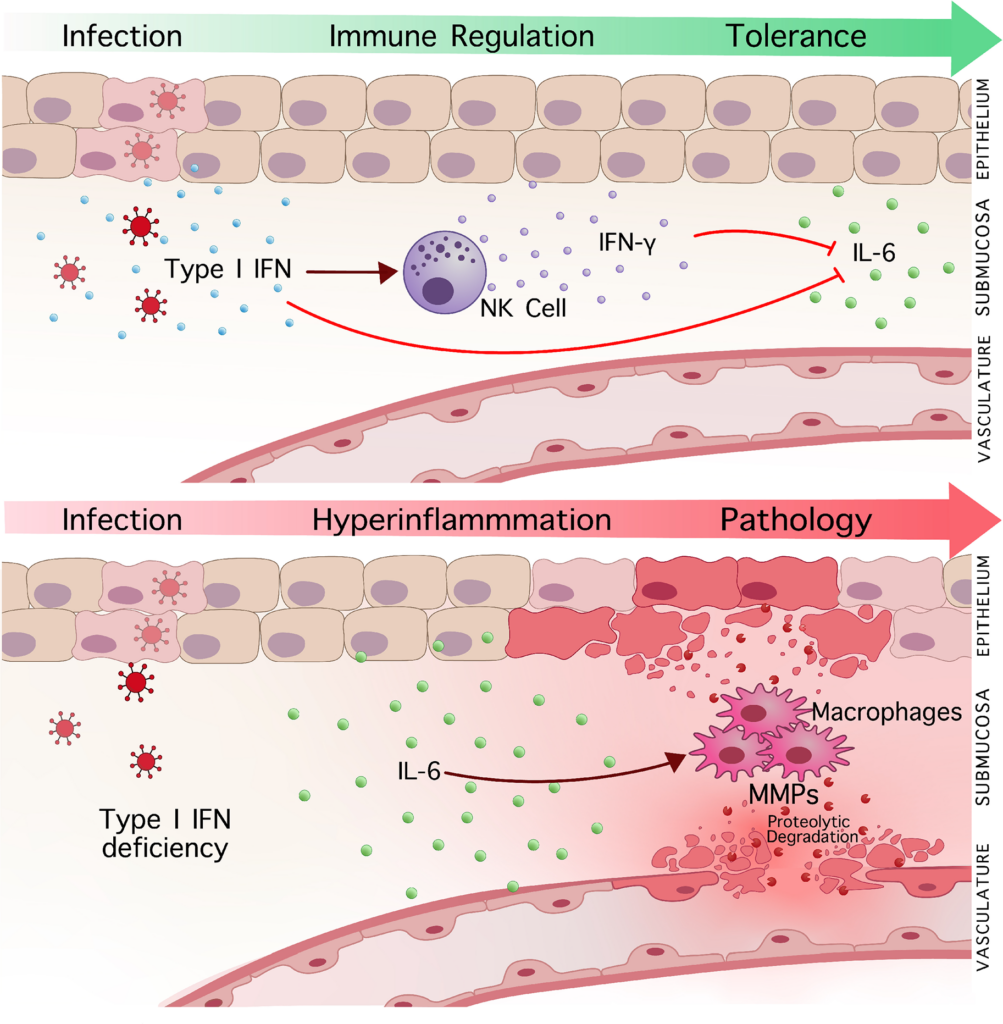During viral infections, it is not the virus that damages tissues the most but the increased activation of the immune system. Type I interferons contribute to viral suppression and reduce excessive inflammatory responses, improving the disease outcome, as reported by Canadian scientists in May 2022.
The outcome of a viral disease depends on how effective the early response of the innate immune system to the virus is. The immune system can damage organs and tissues if inflammatory responses increase uncontrollably.
Type I Interferons Regulate The Strength of The Antiviral Response
Type I interferons (IFN) regulate the early response of the innate immune system and are responsible for the outcome of a viral disease. Thus, in herpes simplex type 2 infections (genital herpes, HSV-2), IFN-I triggers an early antiviral response by attracting monocytes and stimulating NK cells to produce IFN-gamma, which is necessary to suppress the virus. In the later stages of infection, IFN-I, on the contrary, suppresses the production of IFN-gamma, preventing tissue damage.
The absence of an early response to IFN-I leads to increased viral replication and reduced survival in genital herpes. Restoring a normal reaction to IFN-I or IFN-gamma prevents tissue damage.
Pro-inflammatory cytokines such as IL-6, TNF-α, and IL-1β are involved in tissue damage by the immune system. Elevated IL-6 worsens severe forms of COVID-19 and influenza. In addition, IL-6 is the driving force behind the cytokine release syndrome. Suppression of IL-6 responses may impair leukocyte recruitment to the site of infection and attenuate antiviral responses of T cells and neutrophils.
Type I interferons are required to suppress cytokine-induced hyperinflammation during infection
In mice, the lack of type I interferon signals resulted in severe tissue damage during genital herpes. Without interferon signals, IL-6 stimulated macrophages to produce matrix metalloproteinases (MMPs), which disrupted tissue structure.
It was enough to act on one of the links of the pathological process to prevent tissue damage:
- suppress MMP activity;
- deplete macrophages and suppress IL-6 signaling;
- restore normal IFN-I signaling that suppressed IL-6 production.
The immunoregulatory function of type I interferons does not depend on the location and type of viral infection. While IL-6 stimulates macrophages, IFN-I suppresses macrophage activity, inhibits MMP production, prevents tissue damage, and improves disease outcomes.
Suppress MMP Activity by Limiting Tissue Damage
In an experiment on mice, inhibition of MMP activity increased survival in genital herpes.
MMP activity was suppressed with doxycycline. Without a type I interferon response, doxycycline treatment reduced the destruction of the vaginal epithelium and submucosa but did not eliminate the pathology. Doxycycline had no antiviral effect.
Increased MMP expression in COVID-19 patients suggests that MMP inhibitors may effectively treat severe human coronavirus infection. However, this is a topic for further research.
Macrophages and MMPs are Strongly Associated with Tissue Damage and Coronavirus Mortality
Severe coronavirus infection is associated with extensive pneumonia. Significant macrophage infiltration and MMP expression were observed in the lungs of patients with severe COVID-19.
IFN-I signaling is essential for protection against severe coronavirus. At the same time, the IFN-I response is reduced in patients with severe coronavirus. Early production of type I IFN is associated with improved COVID-19 outcomes. The introduction of type I interferon in the early stages prevents tissue damage, but in the later periods, it increases inflammation.
Conclusion
Type I interferon signaling prevents tissue damage and improves the outcome of viral infections.
In the absence of type I interferon signaling, elevated levels of IL-6 cause hyper inflammation and tissue damage. IL-6 stimulates macrophages to produce MMP enzymes that cause severe tissue damage during infection. Suppression of MMP activity can significantly reduce virus-induced tissue damage.
Type I interferon signaling inhibits increased IL-6 production and macrophage activity by inhibiting macrophage production of MMP. IFN-I promotes the activation of NK cells and the production of IFN-gamma. IFN-gamma counteracts IL-6 signaling and MMP activity, suppressing IL-6-induced inflammation and preventing tissue damage.
The protective mechanism of IFN is illustrated in the figure:
Image source: https://journals.plos.org/plospathogens/article?id=10.1371/journal.ppat.1010471
Useful article, necessary information? Share it!
Someone will also find it useful and necessary:




